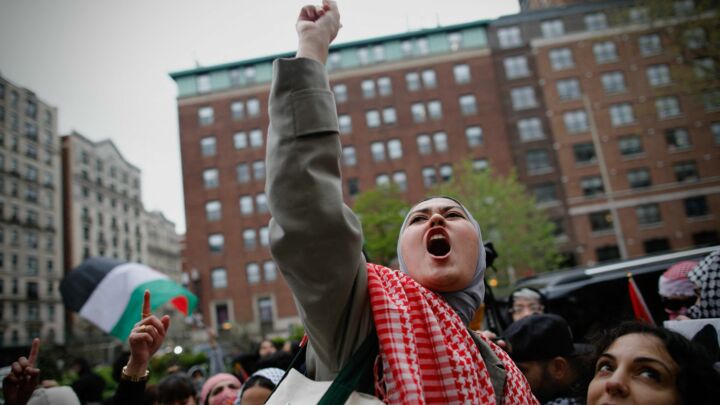The barbarians within the arts establishment
The drive to use art to change people’s behaviour is as contemptuous of us as it is of culture.

Two recent proposals for UK government policy should strike alarm in the heart of anyone who cares about free will, let alone the true value of art. John Holden’s Culture and Class, and Arts Funding, Austerity and the Big Society: Remaking the case for the arts by John Knell and Matthew Taylor, are each couched in lofty language about creativity and democracy, but the implications of their arguments are ominous for both.
Holden and Taylor are both influential in British arts strategy. Taylor was director of policy for New Labour’s 1997 election campaign and, later, Blair’s strategy adviser; he now heads the Royal Society of Arts (RSA). Holden is an ex-investment banker who was later head of culture at think tank Demos and is now a visiting professor at City University. Both are interested not just in social policy but in the ways in which government can get people to do what it wants. And they both see the arts as a means to change our behaviour.
Taylor, for instance, thinks the arts can ‘have a powerful impact on citizen engagement and pro-social behaviour, behaving in ways that strengthen society’. He wants to nudge the recalcitrant among us into behaving properly, or as he loftily puts it ‘we are less aiming to “nudge” people to do good than give them the information which might enable them to better steer a course through a modern world using a prehistoric brain’.
Holden’s argument is more subtle. ‘In Britain today, part of the population is culturally and creatively disenfranchised’, he tells us. ‘Status, education, wealth and culture march together, so one way of helping the disadvantaged is to increase their cultural capital.’ The problem the impoverished face, therefore, is that access to ‘cultural capital’ is withheld. ‘[They] find it difficult to enter the cultural workforce, since they are unable to take unpaid internships and are not connected to the social networks that provide routes into employment… they are invited to subscribe to, rather than shape, the culture that is on offer. But most of all, they are alienated. Arts events and arts institutions are uncomfortable places to be if you don’t know the rules.’
Yet Holden is careful to elide any distinction between what was once called ‘high’ art and what he calls ‘homemade culture’. So while he seems concerned that more managers than manual workers go to museums, he is also keen to remind us that ‘the era of different classes having easily identifiable and separate cultures is long gone’. For Holden, ‘culture is created by millions of individual and collective decisions, rather than flowing from the tastes and preferences of only one part of society’. ‘To provide children with an education only in traditional received culture does them a disservice. Children need to know about Shakespeare and Wordsworth, but they also need to know about hip-hop and manga comics’.
In which case, given the ubiquity of cultural production, just how much of a problem is ‘access’ really? After all, surely the one thing you need do to ‘enter the cultural workforce’ is to create art – music, words, images – none of which needs to be expensive, let alone require a university degree. (Perhaps Holden is referring to jobs at the Arts Council or similar – but working as a ‘creative facilitator’, community arts officer or curator is not art: it’s a job.) And as Holden himself admits, ‘Almost the entire population takes part in some form of cultural activity, even if that mostly falls outside the commonly adopted criteria for measuring participation in the arts and heritage. Pretty much everyone listens, reads, watches, dances and sings.’ So if everyone makes culture and always has, why do the less well-off now need special help to access it? Eminem, Calle 13 and Dizzee Rascal have managed great success, despite being ‘disadvantaged’ in Holden’s terms.
It’s significant in this context that Holden wants to hire arts professionals to use ‘social networks’ to ‘facilitate social behaviour’. In fact, Holden wants to use the arts to create a society just like this one but happier: ‘could the mass realisation of personal creativity offer a new economic model, producing a kind of capitalism that is not simply about increasing GDP and accumulating money, but about the growth of human capacities and the human spirit?’
As for Taylor, he barely even pretends to be interested in art as art. He just wants to use it as an ‘engine of civic renewal, nurturing social capital and trust by strengthening friendships, helping communities to understand and celebrate their heritage, and… providing a safe way to discuss and solve difficult social problems’. Since much of people’s engagement with art is in their spare time, Taylor is keen to find better ways to monitor what people get up to: ‘If we are concerned with the overall impact of the arts, measurement tools should be extended across this whole ecology, with evidence for artistic instrumentalism garnered, for example, from active citizens whose creativity and cooperation are fuelled by attending great productions unencumbered by subsidy, or by discussing texts bought or borrowed in a book club.’
Of course it would be nice if more people were being more creative. Taylor and Holden are both keen on people ‘participating’ in art rather than merely ‘spectating’. But surely if Holden really wanted to make it easier for the less well-off to ‘access’ culture, he would address people’s poverty? And if Taylor wants to solve difficult social problems, why exploit art to do so? The powers that be have always tried to use the arts for their own agendas, and imagined that their view of the world is the only right one. But a generation ago, such people also had more confidence in themselves, and hence in the degree to which they could civilise the masses.
Artists were once as much a part of society as plumbers and hairdressers, but throughout the last century art was shunted out of our everyday lives and turned into this special thing that only ‘artists’ do. Nowadays, the establishment has realised that decoupling art from its organic position in society, and labelling it as something that only an educated elite can understand, is old-fashioned. But that old orthodoxy has been replaced instead with the notion that what those at the bottom of the social pile need is art.
On the surface this seems more positive. But there’s a big difference between a society of free individuals with the luxury of time to dream, and a society of materially impoverished individuals that has ‘art’ thrust upon it. In Britain, art is no longer seen by the elite as a way of raising the lower orders from their spiritual impoverishment; it is used to reconcile them to their material impoverishment.
So in Culture and Class Holden argues for redirecting funding from maintaining the nation’s treasures in galleries and museums towards ‘attempting to produce culturally confident individuals with creative capabilities’. Under this plan, the Arts Council would presumably employ a small army of arts facilitators / coordinators / curators / mentors / artists-who’ve-lost-their-grants to interfere in the creative lives of people, their families and their ‘social networks’, in the cause of social harmony.
There’s nothing wrong with the state funding of art education for children; school trips to the opera or theatre would be a fine thing. But Holden and Taylor are talking about the state getting proactively involved in the private, creative activity of adults. They’re blind to the fact that adults – poor and rich – should, by definition, be left alone to decide for themselves whether to use their free time to go to museums, or to paint a masterpiece in their bedrooms, or just to watch football.
Holden is right to say ‘we’re in a “culture war”’. But the danger to the arts today is not from the barbarians at the gates, but from within the arts establishment itself.
The consequence of this instrumental approach is that the arts industry is now stuffed with frustrated artists working as educators, facilitators and such like. (I’ve lost count of the number of such people at social and cultural events who’ve told me they never get time to do their art.) A generation of art students has graduated with the inbuilt expectation that they can’t survive as artists without state help. And the social and political outcomes? If anything, we as a society are more distrustful of each other than we were 10 years ago. It’s now quite common for sensitive, intelligent people to confide that they don’t really like other people and think that most are thick.
Taylor thinks that official interest and intervention in our private affairs – in this case, our cultural activities – is to be applauded. After all, as far as he’s concerned, the state’s intervention is all for our own good. But is it not equally likely that the authorities’ ever increasing interest in what we say to each other, how we bring up our children, what we eat and drink – and now, potentially, how we spend our time creatively (or not) – is likely to reinforce our atomisation? That is, it seems just as likely that we might adjust to the constant undermining (for our own protection of course!) of our autonomy as adults, by becoming more insecure, more dependent on approval from outside – and, as a result, less creative.
For many ordinary folk today, beset by worries about losing their jobs and homes, their personal project – whether that be amateur dramatics, shooting films, singing in a local choir, or writing poems in their bedroom – is the last bastion of creative action, the one area of life where they’re free to play. The consequences of Holden’s proposal for more state involvement in ‘homemade’ art, and Taylor’s for arts organisations to ‘exploit their full potential in encouraging active citizenship’, are too depressing to imagine.
Holden and Taylor naturally accept the current social system as fixed, and believe their view of the world is the only possible one. Their backgrounds lead them to assume they understand how society works better than most. What they fail to grasp is that the more the state interferes with our personal lives and what goes on in our heads, the worse it is for art and individual freedom.
Jan Bowman is an artist and illustrator, and author of This is Birmingham. (Buy this book from Amazon (UK).) Visit her website here.
To enquire about republishing spiked’s content, a right to reply or to request a correction, please contact the managing editor, Viv Regan.








Comments
Want to join the conversation?
Only spiked supporters and patrons, who donate regularly to us, can comment on our articles.